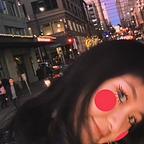HCDE 451 A8: Fabric Construction — A UX Designer’s Tool Bag
Design
The design for this week is to design a simple wearable object out of fabrics. I decided to sew a small tool bag for carrying materials for usability testing such as sticky notes, markers, and other necessary tools.
This bag must satisfy the following requirements:
- must use a sewing machine to connect and assemble the parts
- must use some sort of fastening mechanism as part of the design
I chose to make a tool bag because I think it would be more effective if all the tools are kept in one place during the testing. Large Capacity and Mobility are the two most important criteria for this tool bag.
After sketching out the possible designs for the bag, the next step was to sew a low-cost muslin prototype to test out the shape and determine the size and construction method. At first, I planned to sew a small tote bag.
After I saw the prototype, I gave up on the idea of making a tote bag because it was nonsense to make a bag handle for the bag with such a small size. Suddenly, the idea of a barber’s tool bag just appeared. I decided to change my original plan and make a side bag instead. I decided to make a side bag fasten by buttons.
I thought it would be more effective and fun to add some pockets on the outside of the bag. I used needles to locate the yellow and purple geometries to see where to put them on.
Final Showcase
Analysis
What Worked Well
- the large capacity of the bag
- the outside pockets for both decoration and storage purposes
This bag satisfies the most important criteria by being able to store 10+ pens, sticky notes, and extra stuff. I also received many compliments from my classmates about the design of the outside pockets. They thought it was cute and perfect for storing small things like erasers.
What Needed Improvement
- Fabric choices
- Sewing skill
- Color choices (for thread)
The light cotton fabric is used majorly for clothes but not for bag design because it is not stiff enough to create shapes or provide support. This tool bag works fine for carrying pens, sticky notes or something lighter but not for the tools with sharp edges such as scissors or something with weight. During the testing, when I tried to place a pair of scissors into the bag, I was afraid that it would poke a hole the next second. The cotton fabric was way too light and thin. I need to consider more including the texture, pattern, and strength when picking up the fabric.
The next thing that needs improvement is my sewing skill because it is terrible. I need to practice more to at least get a neat and straight stitching line. And due to the color I mistakenly picked for the thread, the rough stitching lines were emphasized. I should pick the thread color either lighter or match with the fabric’s color.
Effectiveness
I think the side bag design is more effective than the tote bag design. I measured the bag strap length to fit my height so it would perfectly fall between either side of arms and hipbones. This design is effective because it frees my hands and allows me to quickly get the tools from the bag with one movement instead of searching from the backpack. Hence I can continue what I was doing before.
Overall, I felt that my bag had successfully delivered my concepts, though there could have been more effort into practicing the sewing skill to make it look more clean and professional.
